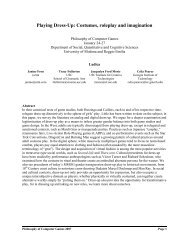The Irreducible Self: Image Studies of First Person
The Irreducible Self: Image Studies of First Person
The Irreducible Self: Image Studies of First Person
Create successful ePaper yourself
Turn your PDF publications into a flip-book with our unique Google optimized e-Paper software.
6Now what a first person shooter game as an image achieves is to show this intentional relation<strong>of</strong> a self to the world and its objects. But it does not only “show” it, as Wittgenstein says, butfurthermore forces the player to make use <strong>of</strong> the picture as if the self existed. This is the keypoint to my argument: I would not say that the I or the self exists in the metaphysical or evenin the biological sense. Presumably no one will ever find a pro<strong>of</strong> for this – but the simulationpicture <strong>of</strong> a first person shooter demands that the user behaves as if his I or self existed. Andthis behavior or interaction with the image-objects presented by the video game derives fromthe perspectival organization <strong>of</strong> the simulation image. <strong>The</strong> main characteristic <strong>of</strong> this image isthe alignment <strong>of</strong> the vanishing point with the junction <strong>of</strong> the crosshairs in the view-finder <strong>of</strong>one’s weapon. It is by virtue <strong>of</strong> this fact that the image presents intentionality.<strong>The</strong> movement in virtual space thus is secondary to this primary interaction: for thepredominant action is when the player has to make an object coincide with the vanishingpoint. Factually, he or she does not move in space, but rather primarily moves space itself. Inthe simulation image the line <strong>of</strong> sight is centralized and fixed, and what is steered by theinterface is the virtual space around it. <strong>The</strong> simulation picture <strong>of</strong> the first person shooter typethus visualizes intentionality and, furthermore, uses it as the major basis for interaction. Andthis interaction derives from the image’s composition alone.4. ConclusionMy argumentation results in two consequences: on the one hand, I have intended to show thatcomputer games must be analyzed as images. Through such an analysis, we may find a thirdway: approaching these artifacts neither as a form <strong>of</strong> narration in a new medium nor as a rulebased in the virtual realm. On the other hand, I hope to have demonstrated how this approach<strong>of</strong>fers a contribution to the philosophy <strong>of</strong> computer games: taken as (interactive) picture,certain video games have the potential to give a pro<strong>of</strong> in the form <strong>of</strong> an image for theexistence <strong>of</strong> a highly disputed philosophical entity, namely the <strong>Self</strong>.






